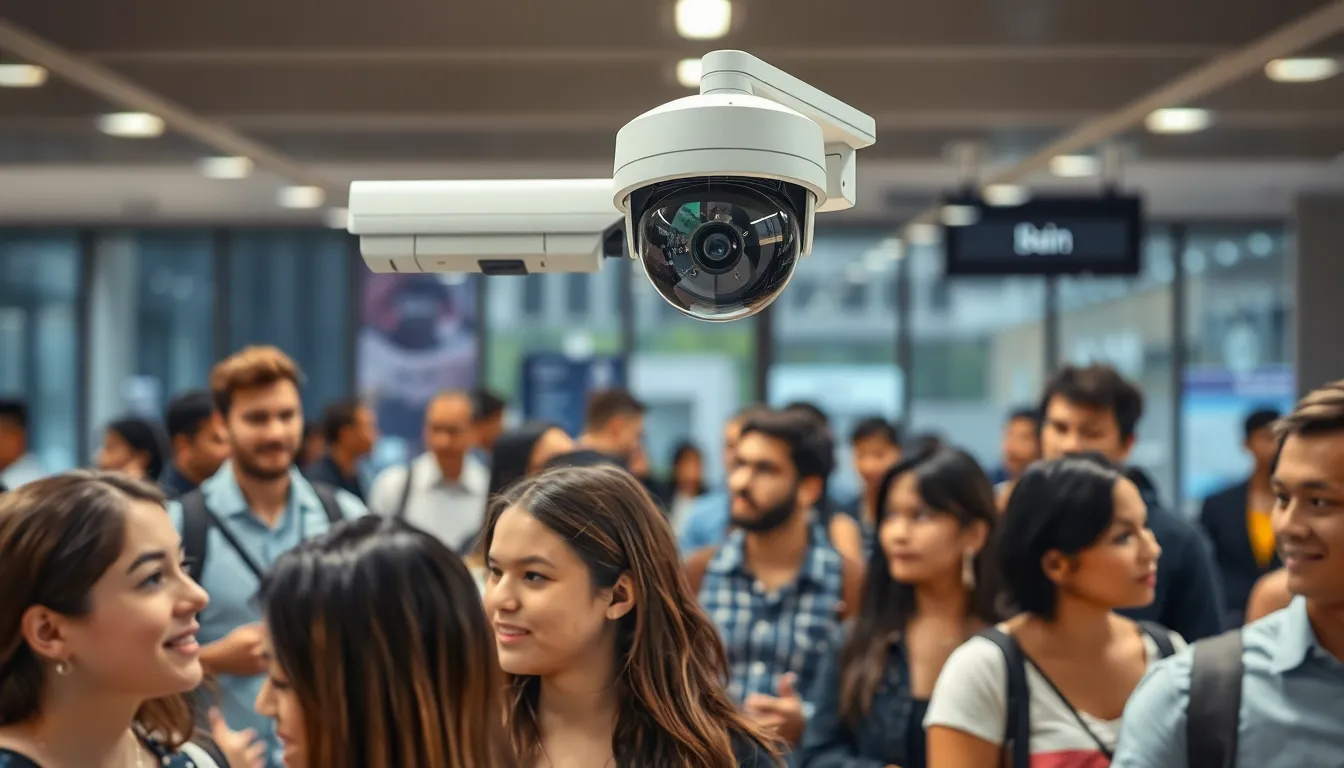Facial recognition software is the tech world’s equivalent of a super-sleuth sidekick, effortlessly identifying faces faster than you can say “cheese.” From unlocking smartphones to enhancing security systems, this innovative technology is revolutionizing how we interact with the digital realm. But while it may seem like something straight out of a sci-fi movie, it’s very much a part of our everyday lives.
Table of Contents
ToggleOverview of Facial Recognition Software
Facial recognition software uses advanced algorithms to identify and verify individuals by analyzing facial features. This technology plays a crucial role in various applications, influencing daily life significantly.
What Is Facial Recognition Software?
Facial recognition software is a technology designed to identify or verify a person’s identity using their facial features. It captures images from various sources, such as cameras or smartphones, and associates them with a known identity. Users employ this software for security systems, social media tagging, and even personalized marketing approaches. Organizations leverage its capabilities to enhance customer experiences and streamline operations.
How It Works
Facial recognition software operates through several key steps. First, it captures an image or video feed of a person’s face. Next, the software detects facial landmarks, identifying unique aspects like distances between eyes or the shape of the jawline. Then, algorithms convert the facial features into a numerical representation, known as a faceprint. Finally, it compares this faceprint to existing databases to find a match. This process happens in seconds, making it an efficient solution for identity verification and security measures.
Applications of Facial Recognition Software
Facial recognition software plays a significant role across various sectors. Its diverse applications enhance security measures, improve marketing strategies, and innovate healthcare solutions.
Security and Surveillance
Security systems benefit greatly from facial recognition technology. Surveillance cameras equipped with this software can analyze video feeds in real time, alerting security personnel to potential threats. Identifying individuals in crowded spaces becomes more efficient, improving safety in public areas. Law enforcement agencies also utilize facial recognition for identifying suspects and missing persons. With reports indicating that 95% of police departments in the U.S. are using some form of this technology, its influence on crime prevention strategies has become undeniable.
Marketing and Advertising
In marketing, facial recognition software enhances personalized advertising efforts. Retailers deploy this technology to analyze customer demographics and engagement, tailoring advertisements to specific audiences. Programs detect emotions and reactions, allowing brands to fine-tune their approaches. According to recent studies, personalized campaigns can see up to a 20% increase in engagement rates. Additionally, loyalty programs leverage facial recognition for seamless checkouts, providing customers with a more convenient shopping experience.
Healthcare Innovations
Healthcare applications of facial recognition software include patient identification and tracking. Accurate identification reduces medical errors and enhances patient safety in hospitals. This technology can also monitor patients’ emotions and stress levels, assisting mental health professionals in tailoring treatments. Hospitals using facial recognition systems have experienced up to a 30% reduction in patient misidentification. Innovations in telemedicine further highlight its potential, allowing healthcare providers to secure remote consultations efficiently.
Benefits of Facial Recognition Software
Facial recognition software offers several significant advantages that enhance various aspects of technology and security.
Enhanced Security Measures
Enhanced security measures drive the adoption of facial recognition technology. It enables real-time monitoring in public spaces, allowing for quick detection of potential threats. Law enforcement agencies benefit from immediate identification of individuals involved in criminal activities. Moreover, it supports access control systems, ensuring that only authorized personnel enter secure areas. Businesses utilize it to safeguard premises and deter unauthorized access, leading to a safer environment for everyone. The ability to analyze video feeds in real-time significantly improves response times during emergencies.
Improved User Experience
Improved user experience plays a vital role in the appeal of facial recognition software. This technology streamlines processes like smartphone unlocking, making it faster and more convenient. Users enjoy personalized services that adapt based on their faces, such as tailored advertisements and content recommendations. In retail establishments, it enhances customer interactions by recognizing frequent shoppers, allowing staff to provide better service. Additionally, users appreciate the privacy features that often accompany these systems, promoting trust and comfort. Overall, the seamless integration of facial recognition into daily activities enriches interactions with technology.
Challenges and Concerns
Facial recognition software presents several challenges and concerns that require careful attention. Privacy issues and ethical considerations play a significant role in the ongoing debate surrounding this technology.
Privacy Issues
Concerns about individual privacy arise with the use of facial recognition software. Surveillance systems often collect data without user consent, leading to feelings of mistrust. Many fear unauthorized access to their facial data, increasing the risk of misuse. Legal frameworks in various jurisdictions struggle to keep pace with technological advancements, leaving gaps in privacy protection. Transparency in data collection practices remains essential to address these concerns. Clear policies regarding how data is stored and used can help alleviate public anxiety. Establishing guidelines for consent can improve user confidence in facial recognition applications.
Ethical Considerations
Ethical questions frequently emerge from the deployment of facial recognition software. Issues like bias in algorithms may disproportionately affect certain demographics, leading to unfair treatment. Developers must focus on creating technology that promotes equality and inclusivity. Accountability for potential misuse becomes paramount; stakeholders need clear frameworks to address unethical applications. Social implications of surveillance, such as chilling effects on free expression, merit serious consideration. Organizations that use facial recognition systems should evaluate the potential impacts on civil liberties and human rights. Engaging in ongoing discussions about these ethical dilemmas can guide responsible technological development.
Future Trends in Facial Recognition Software
Facial recognition software continues evolving rapidly, reflecting advancements in technology and shifting societal attitudes. Innovations in this field shape its future, bringing new capabilities and applications.
Technological Advancements
Rapid improvements in artificial intelligence enhance facial recognition software, increasing accuracy and efficiency. Recent breakthroughs in deep learning enable algorithms to analyze facial features with greater precision. Increased computing power supports real-time processing, making instant identity verification commonplace. Facial recognition systems now integrate seamlessly with other technologies, like augmented reality and Internet of Things devices. Privacy-preserving techniques also emerge, allowing data processing without compromising individual identities. Examples include federated learning, which trains models without accessing user data directly. Such advancements set the stage for broader adoption and more sophisticated applications across sectors.
Regulatory Developments
Regulatory frameworks are beginning to adapt to the growing presence of facial recognition technology. New legislation targets the ethical use and deployment of this software, aiming to address privacy concerns. In jurisdictions worldwide, proposals emerge that require explicit user consent for data collection and processing. Countries like the European Union move toward stricter regulations governing biometric data, setting precedent for global standards. Collaboration between authorities and industry stakeholders fosters responsible innovation. Increased transparency ensures that organizations disclose their practices to the public. Addressing these regulatory challenges is vital for gaining public trust and ensuring the technology’s responsible advancement.
Conclusion
Facial recognition software is reshaping how society interacts with technology. Its applications span security systems, marketing, and healthcare, enhancing user experiences and improving safety measures. However, the challenges of privacy and ethical considerations cannot be overlooked. As technology evolves, the need for transparent practices and responsible development becomes increasingly critical. Balancing innovation with accountability will be vital in fostering public trust. The future of facial recognition holds promise, but it must be navigated thoughtfully to ensure it serves society positively.





